Booming. Surging. Growing. Like oil production in the Bakken formation, that’s what is happening to communities in the northwest corner of North Dakota. In fact, a brand new $275 million airport, Williston Basin International (XWA), opened in October to keep up with the unprecedented economic expansion.
Booming. Surging. Growing. Like oil production in the Bakken formation, that’s what is happening to communities in the northwest corner of North Dakota. In fact, a brand new $275 million airport, Williston Basin International (XWA), opened in October to keep up with the unprecedented economic expansion.
The new airfield and terminal are located in Williston, a rapidly growing community 60 miles from the Canadian border and 18 miles from the Montana border. The city sits atop the vast Bakken oil formation, which exceeded the 1 million barrels per day production level in 2014, making North Dakota the nation’s second largest oil-producing state in the U.S. The booming production drew new workers and businesses to the region—surging population in Williston from about 14,000 in 2010 to an estimated 27,000 in 2018.
The city’s new airport, XWA, replaces its previous airport, Sloulin Field International (ISN), and is roughly twice its size. As the local economy and population grew, so did enplanements at ISN. Soon, the growth presented substantial challenges for the airport, which was designed for small aircraft and much less passenger traffic. The 10,000-square-foot commercial terminal added in 2005 was designed to handle about 10,000 annual enplanements, which “was perfect for those times,” notes Airport Director Anthony Dudas.
|
Project: New Airport Location: Williston Basin Int’l Airport (ND) Owner: City of Williston, ND Total Est. Cost: $275 million Land & Airfield: $165 million Terminal & Support Facilities: $70 million Roads, Parking Lots & Utility Extensions: $30 million Planning & Environmental: KLJ Terminal Surveying: KLJ Designer of Record for Runway 14-32, Parallel Taxiway, Commercial Apron: KLJ Designer of Record for General Aviation Area, Roads & Parking Lots: Burns & McDonnell; KLJ Designer of Record for NAVAIDs: Burns & McDonnell; KLJ Designer of Record for Airfield: Burns & McDonnell Architect for Terminal & Snow Equipment/ARFF Building: Alliiance Engineering: KLJ Owner’s Representative: Cardon Global Construction Manager at Risk (Terminal & Snow Equipment/ARFF Building): JE Dunn Construction Project Manager: Ulteig; AE2S Operational Readiness Services: Chrysalis Global Aviation Exit Lane Breach Control: Dormakaba Boarding Bridges: JBT AeroTech Beam Seating & Recliners: Vitra Lounge Seating: Decca; Martin Bartrud Recharge Seats: Andreau World Ground Handling Services: DGS Of Note: Rapid economic expansion related to oil production prompted city to replace small existing airfield with larger new greenfield airport |
Then, a resurgence of oil production in 2014 quickly rendered ISN decidedly undersized. “Who would have forecasted that type of growth for our community?” Dudas muses.
As the city and its planning team, led by KLJ engineering and planning services, considered whether to renovate or replace ISN, new commercial jet service added in 2012 definitely tipped the scales. Prior to that, ISN was served exclusively by turboprops through Great Lakes Airlines. With the upgrade to commercial jets from Delta Air Lines and United Airlines, ISN grew from less than 10,000 enplanements in 2009 to more than 120,000 in 2014—a 960% increase (yes, you read that right).
“The terminal was just not designed to handle what we’re seeing today, let alone the traffic that came when we commenced that jet service,” Dudas says. For example, the secure area in the terminal was designed for 41 people, which means it could not accommodate a single 50-passenger regional jet.
As a temporary measure to expand capacity, the airport added a doublewide trailer that accommodated up to 130 passengers at a time. “But it didn’t have all of those amenities that you would expect at a modern airport facility,” Dudas notes. Moreover, ISN did not have a baggage claim or passenger boarding bridges, which were sorely missed during cold North Dakota winters.
The ISN terminal was so undersized that TSA could not squeeze in an automated baggage screening device, so all checked baggage was hand-screened. Airport administration offices were moved to a separate facility to make room for rental car and airline operations.
Airside, the Category B paved surfaces and related infrastructure were designed to accommodate aircraft less than 25,000 pounds. ISN’s runway length (6,650 feet) and slope (1.3%) do not meet FAA design standards for larger corporate jets or the type of aircraft commercial carriers typically use to service communities the size of Williston. An elevation change of 90 feet from one end of the runway to the other created “challenging operational characteristics” for airlines and general aviation operators, Dudas notes. “We saw substantial weight restrictions because of that slope and the obstructions off the end of the runway,” he adds.
Too often, up to 25 passengers would be bumped off of a 50-passenger regional jet because of weight restrictions associated with the runway slope.
With only 803 acres, ISN did not have developable space for expansion. “The city grew up around the airport,” relates Dudas. “We didn’t really have any room for expansion without significant impact to our residential neighbors and the businesses that surround our facility.” And even if the airport purchased surrounding land, it would still have lacked room for future expansion.
Reviewing Options
Following a substantial environmental assessment and a site selection study that included seven different options, the field was narrowed down to three alternatives. One was to reconstruct ISN—a plan that would have required the city to replace virtually every piece of infrastructure. “Essentially, we were building a new airport no matter what—either on Sloulin Field or on a greenfield site,” recalls Dudas.
While ISN could have been renovated, doing so would have been impractical, he explains. Constructing a new airport on a greenfield site allowed traffic to continue operating at ISN during construction of the new airport. Shutting down ISN for a reconstruction that could have taken up to two years would have had a hugely negative economic impact to the community. Additionally, there were fewer environmental impacts to building new, and the expected future sale of ISN will help cover the city’s cost to construct XWA. “Financially, building a new airport made the best sense for our community,” summarizes Dudas.
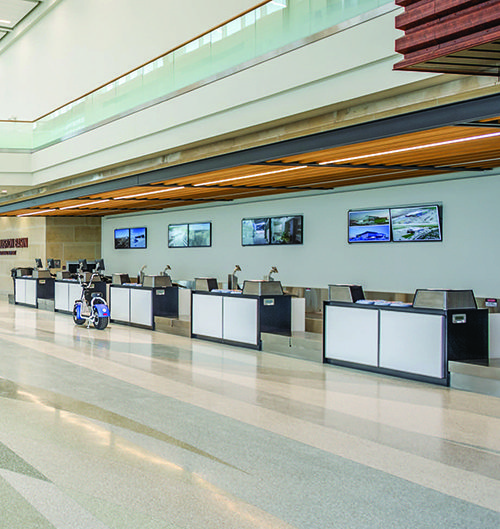
In 2015, an economic impact study conducted by the North Dakota Aeronautics Commission showed that ISN provided $209 million of economic impact to the region.
Using geographic information system modeling with about 160 characteristics for compatibility with airport development, the project team evaluated land in Williams and McKenzie counties. The territory reviewed was from the Montana state line on the west to 20 miles east of Williston and from Alexander north to 15 miles north of Williston.
 Alternatives were ranked based on factors including terrain, wildlife attractants, airspace obstructions, environmental impact and compatible land use (such as proximity to critical infrastructure and access to emergency services). Ready access for passengers was also an important factor. In addition to the city of Williston, XWA serves northwest North Dakota, northeast Montana and Canada. “We want to make sure that all the people can get to our facility easily,” Dudas remarks.
Alternatives were ranked based on factors including terrain, wildlife attractants, airspace obstructions, environmental impact and compatible land use (such as proximity to critical infrastructure and access to emergency services). Ready access for passengers was also an important factor. In addition to the city of Williston, XWA serves northwest North Dakota, northeast Montana and Canada. “We want to make sure that all the people can get to our facility easily,” Dudas remarks.
Naturally, construction cost was a key consideration. “While most people think North Dakota is very flat, western North Dakota is not. It’s pretty challenging to find a two-mile straight line that isn’t either impacted by energy development or terrain,” he explains.
Ultimately, the city purchased 1,620 acres about five miles northwest of ISN to build XWA. The state constructed a new bypass around Williston, which provides easy access to the new airport.
Today’s Terminal
After the site was selected, planners positioned the airfield and terminal to make best use of the acreage and to preserve Native American heritage sites.
 “Being a greenfield site was really a great opportunity,” says Scott Sorenson, lead terminal designer with Alliiance. “The careful planning and siting of the building allows for future growth that can happen in a managed way and still maintain the design intent of the building.”
“Being a greenfield site was really a great opportunity,” says Scott Sorenson, lead terminal designer with Alliiance. “The careful planning and siting of the building allows for future growth that can happen in a managed way and still maintain the design intent of the building.”
The 103,000-square-foot terminal has four gates with three passenger boarding bridges, and is designed to accommodate about 300 passengers per hour at peak use. The terminal opened with one TSA passenger checkpoint, but has the capacity and infrastructure to add two more. “We feel it’s going to be a great entrance to our community,” states Dudas.
Alliiance designed the terminal in three sections: a front zone with public spaces; a center zone that includes most of the infrastructure and permanent fixtures; and a rear zone with passenger gates. This layout allows flexibility for growth off the rear and/or front zones with minimal impact to the infrastructure-rich center area, explains Sorenson.
In fact, the design team conducted three-dimensional studies to analyze the feasibility and logistics of future expansion. The terminal layout can accommodate up to 12 gates without any change to the infrastructure in the center zone.
Passenger amenities include a full-service restaurant, baggage claim, nursing mothers’ room, children’s play area, baggage screening area, passenger checkpoint, more comfortable landside and airside lounge seating, and ramp space for general aviation and commercial aircraft.
An airside restaurant, Refinery Kitchen + Bar, plus a grab-and-go option will add to the passenger experience, notes April Meyer, senior terminal designer-interiors with Alliiance.
The design and layout of the terminal provide expansive views of the prairie, with a drilling rig visible in the distance. “You see Williston’s past, present and future right there,” Sorenson relates.
Stratified limestone from the Missouri River basin is reflected in the exterior façade, running the length of the building and into the interior. Architects also incorporated cues to the region’s industrial and mining sectors. The careful, clean and modern exposure of structural beams was part of that influence, explains Sorenson.
 Interior elements pay tribute to the nearby Badlands, striated limestone along Missouri River bluffs and prairie grasses on rolling plains. The terrazzo flooring is reflective of the prairie, sky and horizon, notes Meyer. Darker colors and curves in the first 40 feet of the terminal lead to lighter, flowing colors. “It’s almost as if it’s pulled in from the exterior to the interior,” she relates.
Interior elements pay tribute to the nearby Badlands, striated limestone along Missouri River bluffs and prairie grasses on rolling plains. The terrazzo flooring is reflective of the prairie, sky and horizon, notes Meyer. Darker colors and curves in the first 40 feet of the terminal lead to lighter, flowing colors. “It’s almost as if it’s pulled in from the exterior to the interior,” she relates.
Airside, a grade-sheltered tug drive allows ground support personnel to access the baggage makeup areas and provides overnight shelter from the elements for equipment.
For high environmental performance, the terminal is well insulated and includes high-efficiency HVAC equipment and LED lighting to maximize energy savings. Exterior shading helps minimize glare from the low-setting western sun.
Expandable Airfield
Runway 14-32 at XWA is 7,500 feet long and 150 feet wide, and is designed to D-IV specifications, for aircraft with single wheel weight up to 120,000 pounds, dual wheel up to 195,000 pounds and dual tandem wheel up to 339,000 pounds. It is sufficient for the currently anticipated traffic, but the city acquired enough property to expand the runway up to 8,500 feet if necessary. The airfield also includes a full parallel taxiway and stub-outs for a future 4,500-foot-long, 75-foot-wide crosswind runway.
XWA has nearly twice the amount of apron space as ISN. A new fixed base operator, Overland Aviation, shares a 51,000-square-foot facility with Customs & Border Protection.
A 29,000-square-foot building houses snow removal equipment and aircraft rescue and firefighting services. It was designed with similar colors and materials as the terminal, notes Sorenson.
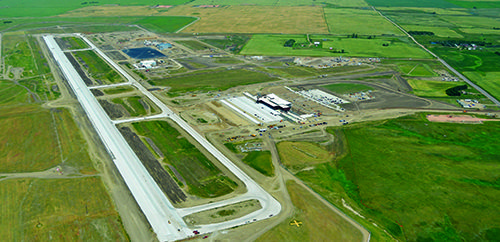
Future Growth
While forecasting is always a challenge, Dudas says that city officials are comfortable that they now have an airport that will accommodate today’s traffic with room to grow. “We didn’t want to be full on day one,” he relates. “We anticipate the terminal building lasting a century, so it needs to be able to accommodate future growth as well.”
He says the current four-gate facility will accommodate three airlines comfortably, and four “relatively comfortably.” With service from Delta and United in place, Williston officials are working to attract a third carrier oriented toward leisure travel.
Like the airport, all city-owned facilities are designed with growth in mind. “That’s one thing we learned from Sloulin Field,” Dudas reflects. “We didn’t want to put ourselves in a position where it wasn’t easy to grow should economics determine that we need to grow.”
Funding/Schedule Challenges
While there are numerous benefits to new construction on a greenfield site, the XWA project also encountered challenges—namely that the federal funding cycle doesn’t gel with the abbreviated construction season in North Dakota.
When all is said and done, cost for the new airport is expected to total $275 million; and city officials expect 50% federal participation. “We had a great partnership with the FAA and state to help fund this project,” Dudas reports. “However, the funding timeline follows the federal fiscal year, so those dollars don’t typically come through until mid- to late-summer; and we have a very short construction window because of winter weather.”
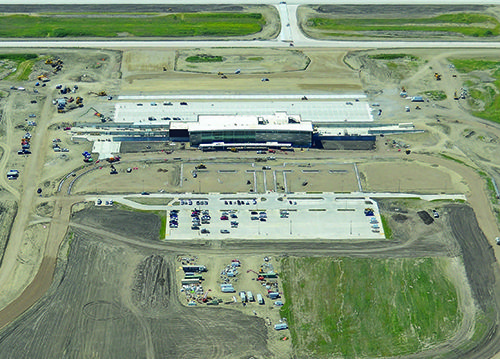
To meet the tight construction timeline, the project had 30+ prime construction contracts active at the same time. “We worked through a very aggressive timeline on this airport relocation project,” he points out.
While 1,600 acres sounds like a large worksite, careful coordination was still necessary to make sure each contractor had necessary site access and did not impede another crew’s work. The city established a program coordination team, headed by Ulteig and AE2S, which controlled and coordinated onsite engineers and contractors.
“I can’t be here every day, and we needed to have ‘boots on the ground,’ to help organize, manage and coordinate all of the ongoing construction,” Dudas says. “The project coordination team was an integral part of making sure that we were going to open this airport on time.”
Working with a lean staff that lacked experience building an entirely new airport, officials say it was necessary to tap industry resources to ensure a smooth, efficient project and transition.
 The firm of Cardon Global was initially engaged to help the city repurpose Sloulin Field after it is decommissioned, but its role was expanded to owner’s representative three years ago. “There are so many people involved in the new airport that the city really wanted to be able to carve out and have this be a singular focus outside of their own capacity,” explains Don Cardon, the company’s chief executive officer. “A lot of our job was trying to make sure that they were being a good fiduciary of the cost implications, but also trying to get construction done quickly.”
The firm of Cardon Global was initially engaged to help the city repurpose Sloulin Field after it is decommissioned, but its role was expanded to owner’s representative three years ago. “There are so many people involved in the new airport that the city really wanted to be able to carve out and have this be a singular focus outside of their own capacity,” explains Don Cardon, the company’s chief executive officer. “A lot of our job was trying to make sure that they were being a good fiduciary of the cost implications, but also trying to get construction done quickly.”
Because ISN operated through the opening of XWA, having an owner’s representative allowed city staff to focus on the existing airport and their roles managing a booming city, without the added volume of details associated with developing a new airport.
In a similar vein, JE Dunn was first hired as construction manager at risk for the snow removal equipment/aircraft rescue and firefighting building in 2016, and was later awarded the contract to be construction manager at risk for the terminal building as well.
The company also provided overall site management for environmental safety and security. With multiple contractors working at a 1,600-acre project site, the city wanted a single point of contact for each company’s safety officer.
 Marc Mellmer, vice president, JE Dunn, acknowledges that the aggressive schedule was challenging, but also notes that applying best practices from other airports and its own experience helped keep the project on task. “There was no roadmap or specific answers to many questions because it had been so long since this had been done,” Mellmer says of constructing an entirely new airport. “Every step of the way was blazing new trails.”
Marc Mellmer, vice president, JE Dunn, acknowledges that the aggressive schedule was challenging, but also notes that applying best practices from other airports and its own experience helped keep the project on task. “There was no roadmap or specific answers to many questions because it had been so long since this had been done,” Mellmer says of constructing an entirely new airport. “Every step of the way was blazing new trails.”
The Transition
Dudas notes that Chrysalis Global Aviation, an airport operational readiness (ORAT) consultant, was a critical resource for meeting the opening day schedule. The city hired Chrysalis to ease the transition from ISN to XWA for the city, airport tenants and surrounding community.
“The transition from one airport to another requires a substantial amount of coordination and planning, and that’s what the transition consultant has helped us accomplish and continues to do so,” he explains.
Chrysalis not only brought expertise about airport openings, it also had specific experience in North Dakota, as it helped debut the new terminal at Minot International Airport (MOT) in 2016. “But this was not just a new terminal—it’s a new airport. And you don’t see those every day,” says Suzanne Phelps, Chrysalis managing partner.
On Oct. 9, the last commercial flight departed ISN around 5:30 p.m. Typically, there are two later departures, but those were cancelled to allow additional time for the move to XWA. Cancelling the 11 p.m. inbound flights on the 9th automatically cancelled the 6 a.m. flight on the 10th and maximized the window the transition team had to complete the move.
While a substantial amount of transition happened overnight on the 9th, much work was completed in the months, weeks and days leading up to opening day. “We wanted just the things needed to handle those last evening flights and very first flights the next morning to be all we touched on the big move night,” explains Phelps.
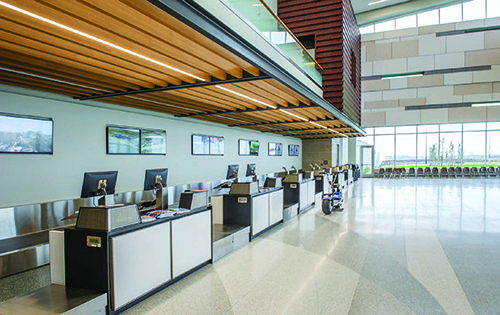
One advantage to XWA being an entirely new airport is that most furnishings had to be new, relates Ann Thorvik, aviation practice lead at Chrysalis. “Many assets were too old or too sparse to be able to populate this beautiful new, large space,” she explains. “We didn’t have to move a lot of the usual furniture, trash cans and other items that often get moved during terminal upgrades.”
Relocating the snow removal equipment, however, was particularly tricky. With a grand opening in early October, one might assume the equipment could be moved prior to the 10th. However, that was not a gamble the airport was willing to make. (Last year, the area received its first snowfall on Oct. 3.)
Extra Challenges
Williston’s remote location, six hours from Fargo, ND, complicated the process of procuring supplies and resources for the transition, notes Thorvik. Lead times and mobilization costs were top of the list for Chrysalis and its associated contractors.
A lack of skilled tradespeople was another issue, notes Scott Vriesman, ORAT consultant with Chrysalis and project manager for the XWA transition. “The oil and gas trades consume most of the labor up here,” he explains.
Reaching out to other firms and sharing crewmembers among subcontractors helped address the labor shortage and kept the project on the tight schedule, Mellmer notes.
But despite careful planning and coordination, the team encountered a few unavoidable challenges. For instance, flooding in Missouri prevented boxcars on rail lines from picking up dry cement in Canada for XWA’s airfield pavement.
“You’d think you could plan for anything,” quips Vriesman.
This material hiccup, in turn, impacted other aspects of construction. “There were a lot of phone calls to change deliveries of everything else,” Thorvik recalls. “For instance, you can’t place a boarding bridge until you’ve got a ramp to put it on.”
Ultimately, it took action from North Dakota lawmakers and the governor to resolve the issue. Instead of the dry cement coming into Williston on rail and being trucked to the site, it came into Minot, 90 minutes away, and the governor reduced restrictions on truck travel between Minot and Williston.
Keeping the community informed was another challenging endeavor. The project team used social media, newspapers, radio, a newsletter and presentations to local clubs to remind the public about the switchover schedule. “We knew that we couldn’t reach everyone, but we made every effort to do so,” says Dudas. “We also had appropriate signage in place at Sloulin Field on Oct. 10th.”
The city and Chrysalis worked together to keep the community engaged and informed throughout the construction process, and through opening. “Our airport operational readiness process isn’t just about training people and moving furniture. It’s about every aspect of continuity for operations,” Thorvik says.

Many aspects of the new terminal simply did not exist at ISN, such as baggage claim, jet bridges and automated baggage screening. Employees needed training about new processes and operating and maintaining associated equipment.
Some elements were new to passengers, as well. To familiarize travelers with the new processes and procedures, community members were invited to tour the new terminal at XWA before it opened. Project personnel then asked if the processes, signage and other key elements made sense. This allowed the airport to address issues and iron out kinks prior to opening day, explains Vriesman.
Taxi operators, hotel vans and oil field shuttles were also given the opportunity to familiarize themselves with the new airport before it opened.
Sloulin Field’s Future
When ISN is completely decommissioned, Williston will have 803 acres of readily developable property in the middle of the city at its disposal. “That’s a pretty exciting endeavor for our community,” Dudas relates.
Just as regional growth prompted construction of a larger airport, it is also creating the need for more schools, medical facilities, retail and housing. As a result, there are many development options already teed up for the land that previously housed ISN.
“We have a substantial shortage of all of those things and more,” says Dudas. “This presents an opportunity to help enhance the quality of life for our region.”
Interest in redeveloping ISN has apparently been substantial. Management from Cardon Global notes that the former airport site will serve as a mixed-use community asset and regional destination that will help accommodate growing interest in North Dakota.
|
Small Details Matter
“We can bring in the experience of what we’ve seen elsewhere,” explains Scott Vriesman, an airport operational readiness (ORAT) consultant with the firm. One example at Williston Basin International (XWA) is the design of the quick turn-around area for the rental car facility. Because of the region’s geography, nearly all of the rental vehicles are pickup trucks and sport utility vehicles. And customers often return them full of clay-like mud that does not easily flow down the drain when crews wash the vehicles for the next customer. As a result, standard drains must be cleared out with a shovel almost every week.
“That seems like a small thing, but if you’re the one with the shovel, that’s a great big deal,” says Ann Thorvik, aviation practice lead at Chrysalis. “This is why ORAT is critical during the Design phase of an effort,” adds Chrysalis Managing Partner Suzanne Phelps. “While many folks tend to think of ORAT as an eleventh-hour activity, careful attention to environment-specific operational needs early in the process yields dividends in the form of change-order avoidance.”
To remedy this, Chrysalis recommended that designers place the personnel entry door at the back of the building and center the garage door on the bay. This provided ample space for all doors of vehicles to be open during cleaning, making the process much easier for employees. “That’s just a small example of the types of things that are uncovered in an operational readiness program,” notes Phelps. “With the operational readiness approach, the idea is to ask the right questions and bring experience from other places so that we uncover these things and mitigate your risk by ensuring nothing gets missed.” “This is why we’re boots on the ground and not sitting remotely in an office making hypothetical checklists,” adds Thorvik. |

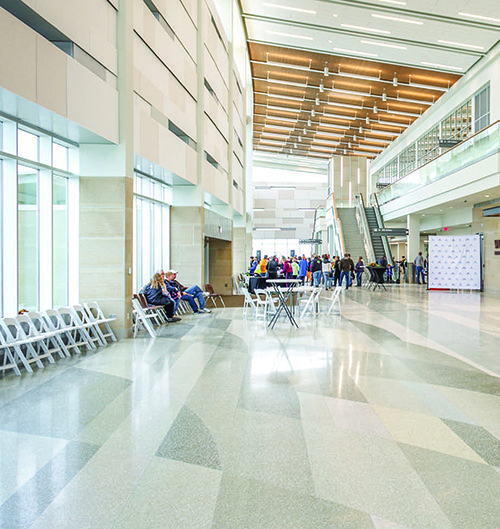
 facts&figures
facts&figures
 After construction, it’s up to airport staff and tenants to operate and maintain a new terminal. Thus, it’s critical for the end-user perspective to be considered throughout the building process. Ferreting out and incorporating that information is the mission of Chrysalis Global Aviation.
After construction, it’s up to airport staff and tenants to operate and maintain a new terminal. Thus, it’s critical for the end-user perspective to be considered throughout the building process. Ferreting out and incorporating that information is the mission of Chrysalis Global Aviation.
 Per Chrysalis’ suggestion, project designers included a 1-foot-wide concrete trench, with the drain bottom at the door instead of at the back of the building. This allows easy access for a vacuum truck to clear the drain of mud and other debris.
Per Chrysalis’ suggestion, project designers included a 1-foot-wide concrete trench, with the drain bottom at the door instead of at the back of the building. This allows easy access for a vacuum truck to clear the drain of mud and other debris.
 XWA will have three rental car operators, but the quick turn area has space for four. The original facility design would have hindered the ability for crews to open all four doors of a vehicle when cleaning it inside the building. “They would have had to close a door to go around, which would have been a lifelong hassle to vacuum the vehicles,” Vriesman relates.
XWA will have three rental car operators, but the quick turn area has space for four. The original facility design would have hindered the ability for crews to open all four doors of a vehicle when cleaning it inside the building. “They would have had to close a door to go around, which would have been a lifelong hassle to vacuum the vehicles,” Vriesman relates.

